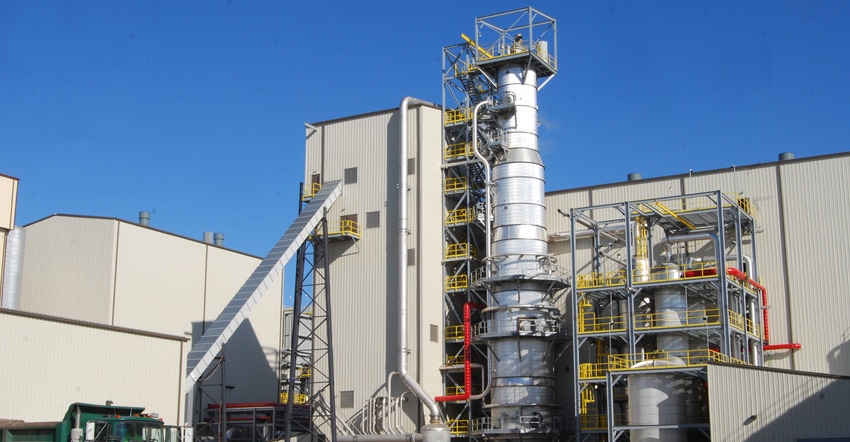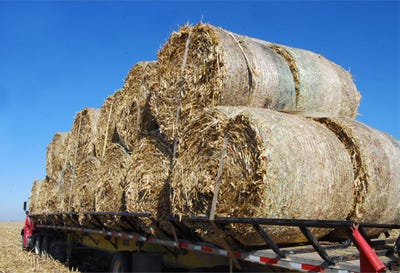December 3, 2019

Ten years ago, there was a lot of hope for cellulosic ethanol. Today, not so much. The last cellulosic ethanol plant making biofuel from corn crop residue — cobs, shucks, leaves, stalks — will soon stop commercial production.
Poet, the nation’s largest ethanol producer, announced Nov. 19 it will continue research and development work at the Emmetsburg, Iowa, cellulosic plant it opened in 2014. But the company will cut about half of the plant’s 70 workers in February, when it ceases cellulosic ethanol production for commercial use. Poet said it will continue to make ethanol from corn grain at the Poet plant next door, which employs 40 people.
In 2010, Poet announced it would build the cellulosic plant next to its grain ethanol facility. I drove to northwest Iowa and attended the groundbreaking ceremony. In September 2014, I was there again for the grand opening of the new plant. So was King Willem-Alexander of the Netherlands and Iowa Gov. Terry Branstad. They joined industry leaders, local officials and a crowd of Iowa farmers to inaugurate commercial production of cellulosic ethanol.
Poet CEO Jeff Broin addressed the audience, saying, “Some have called cellulosic ethanol a ‘fantasy fuel,’ but today it becomes a reality.”
Getting more from corn crop
Broin had high hopes, as did farmers looking forward to the opportunity to sell bales of corn stover to the emerging cellulosic ethanol industry. They’d market corn grain to the grain ethanol plants and stover to the cellulosic plants.
Poet’s cellulosic plant was named Project Liberty. The reason King Willem-Alexander was there was because Poet partnered with a company, Royal DSM of the Netherlands, to build the $275 million cellulosic plant, which today has a production capacity of up to 25 million gallons of cellulosic ethanol annually. Taxpayers invested heavily in the project, as Poet and DSM received about $120 million in state and federal incentives to build the plant and develop cellulosic technology over the decade.
Following Project Liberty’s lead, two other companies built cellulosic ethanol plants — one in Kansas and one at Nevada in central Iowa. The owners of these plants ended up selling their facilities by the end of 2017. Now, at the end of 2019, Poet said it is halting commercial cellulosic production at Emmetsburg and will instead use the facility for research into finding more efficient and lower-cost production.
Environmentally friendly fuel
Cellulosic ethanol can be made from grasses and woody plants, and is classified as an advanced biofuel. Broin and other forward-thinkers were predicting advanced biofuels could supply most of the biofuel someday. One attraction of cellulosic ethanol is its feedstocks can come from plants grown on marginal land or from crop residue, rather than using grain. That would avoid the “food vs. fuel” argument. But cellulosic ethanol proved more difficult and expensive to make than corn ethanol.
Cellulosic ethanol can reduce greenhouse gas emissions up to 95% compared to using gasoline in motor vehicles, so maybe it still has a future as an environmentally friendly fuel. In making the recent announcement that Poet and DSM are halting commercial production of cellulosic ethanol, Hugh Welsh, president of DSM North America, said: “The technological advancements we’ve already made with cellulosic will pay dividends for decades to come as we move toward a low-carbon future — a future we would move to more quickly if EPA would do its job.”
 CASH CROP: Cornstalk balers were a common sight in northwest Iowa in the area around Emmetsburg when the Poet cellulosic ethanol plant opened in 2014. Farmers were enthusiastic about the future for “the new cash crop.”
CASH CROP: Cornstalk balers were a common sight in northwest Iowa in the area around Emmetsburg when the Poet cellulosic ethanol plant opened in 2014. Farmers were enthusiastic about the future for “the new cash crop.”

Poet blames the U.S. Environmental Protection Agency for the “pause in production” at Project Liberty. EPA’s granting of waivers to oil refiners since 2016 has reduced demand for ethanol and biodiesel, cutting prices. The Renewable Fuel Standard is a federal mandate that requires a certain amount of ethanol and biodiesel to be blended into the nation’s fuel supply annually, and EPA sets that volume each year. “Granting the waivers to the RFS over the last three years EPA has held back cellulosic ethanol advancement, hindered future agricultural markets for U.S. farmers and undermined what the president has promised,” Poet spokesman Kyle Gilley said.
About 35 ethanol and biodiesel plants across the country have closed, either temporarily or permanently, because of EPA handing out small-refinery exemptions. Five of the closures are in Iowa, including the Emmetsburg cellulosic plant. Political and industry leaders have demanded EPA make changes to how it handles RFS waivers and fully restore the biofuel demand lost as a result of waivers to oil refineries. That would fulfill a deal President Donald Trump made earlier this year with Midwest Republican leaders.
While EPA continues to ignore the deal Trump made, more jobs have been lost in Iowa. EPA’s policy decisions continue to harm families across rural America. “It’s time to stop this nonsense and uphold the spirit of the RFS,” said Iowa Secretary of Agriculture Mike Naig. “At the same time EPA has granted oil refinery waivers, it has restricted growth of the next generation of biofuel.”
In 2017, DuPont closed its cellulosic ethanol plant at Nevada in central Iowa, and then sold it last year to Verbio North America Corp., a subsidiary of a German company that plans to produce renewable natural gas at the plant.
Next-generation biofuel
When the Emmetsburg cellulosic plant opened five years ago, state and national leaders touted it as a giant step forward in developing renewable fuel. They said the technology would help boost rural economies, creating jobs and paying farmers for corn stover. Poet expected to pay $20 million annually to area farmers for their crop residue. In October 2014, Poet held a field day near Emmetsburg to show how harvesting and delivery of stover biomass bales would work. Poet explained the payment program and were signing up more farmers to participate.
Returning from that field day, I wrote the cover story for December 2014 Wallaces Farmer titled “Iowa’s new crop” — a third crop that could be harvested in a corn-soybean rotation. Poet held the field day, and stover baling and handling demo on Tim and Terry Naig’s farm near Cylinder, east of Emmetsburg. Tim is Mike Naig’s uncle; Terry is Mike’s dad. In the article, they explained that harvesting stover was like adding a second crop or getting more from your corn crop.
Stover harvest requires no farming inputs, such as extra tillage, planting or fertilizing, and has little to no effect on soil sustainability when stover is removed responsibly from fields. The field demos and presentations by Iowa State University and the Natural Resources Conservation Service showed how much stover to leave on the field to prevent soil erosion.
What’s ahead for the Emmetsburg plant? Poet officials say they will continue to improve production efficiency, focusing on mechanical reliability, and develop options for licensing the technology in other countries that “favorably support the use of low-carbon fuels from crop residue and other biomass.” The plant will use the bales of corn stover stored on the site but will not buy additional bales at this time.
Poet also said EPA has changed the approval process, so it slows down the development and commercialization of ethanol technology.
“Because of these policy changes, ethanol in the U.S. makes private and global investments in this technology more challenging and not as attractive,” said Welsh, the DSM North America president. Despite the shift in EPA policy, he said Poet and DSM “remain committed to scaling up this cleaner, renewable fuel as a solution to carbon emissions.”
You May Also Like




